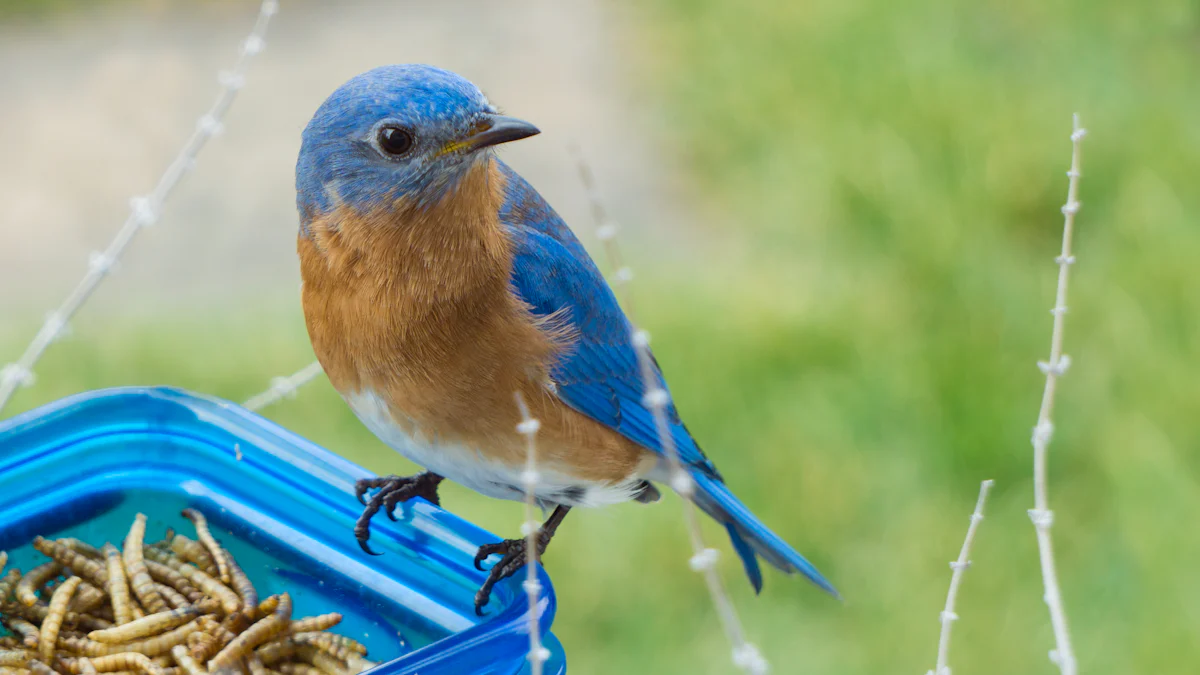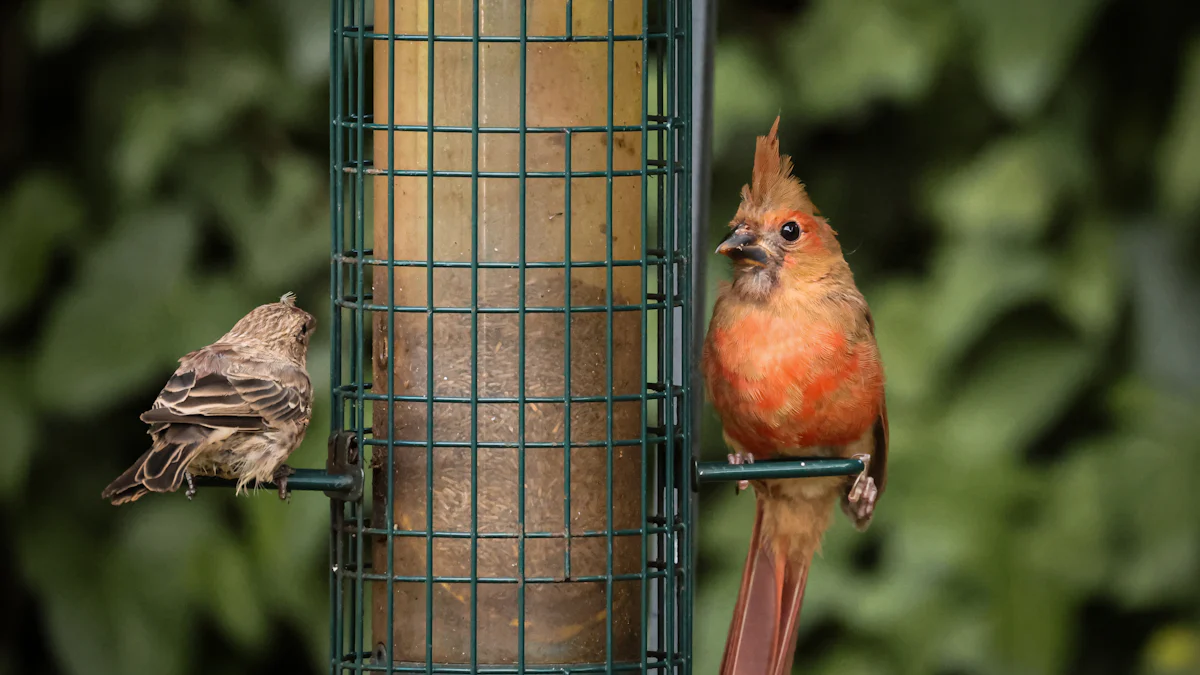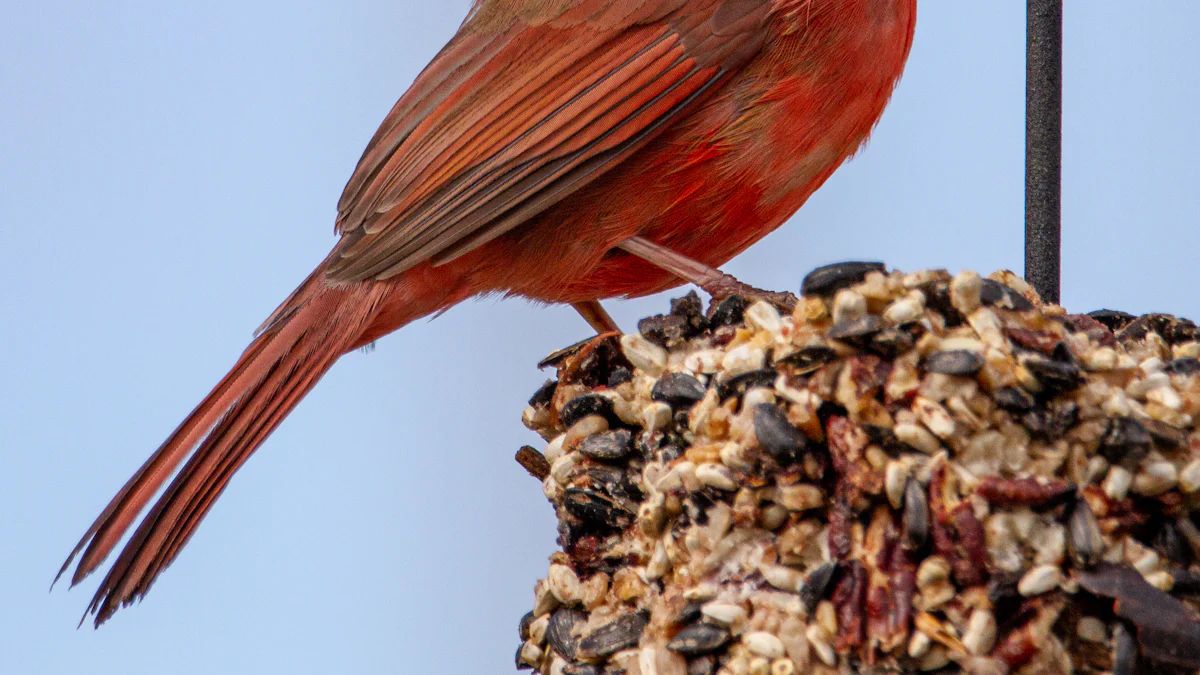
Cardinals love protein-rich foods, and dried mealworms are an excellent choice for them. Over 60% of their diet includes insects like beetles, ants, and caterpillars. These mealworms provide essential nutrients, including protein for muscle health and fats for energy. Unlike fresh food, dried mealworms to birds don’t spoil, making them a convenient option. Chickadees, nuthatches, woodpeckers, and even bluebirds also enjoy them.
Key Takeaways
- Dried mealworms are full of protein and help cardinals stay healthy, especially in winter and nesting times.
- Use a good feeder and put it near trees to bring more cardinals to your yard.
- Slowly add dried mealworms by mixing them with foods cardinals already know to make them try it.
Benefits of Feeding Dried Mealworms to Birds

Nutritional Value for Cardinals
Dried mealworms are packed with protein, making them a powerhouse food for cardinals. Protein plays a vital role in helping birds maintain energy and grow strong, healthy feathers. Compared to seeds or suet, dried mealworms offer significantly higher protein levels, which makes them an excellent choice for cardinals. This nutrient-rich food supports their overall health, especially during demanding periods like molting or raising chicks. Chickadees, nuthatches, woodpeckers, and even bluebirds also benefit from the high nutritional value of dried mealworms to birds.
Seasonal Advantages of Dried Mealworms
Cardinals adapt their diet based on the season, but they always need protein-rich foods. Dried mealworms fit perfectly into their seasonal feeding habits.
- During winter, natural food sources like insects become scarce. Dried mealworms provide essential protein and fat to help cardinals stay warm and energized.
- In the nesting season, female cardinals and their chicks rely on protein to grow and thrive. Dried mealworms are a convenient way to meet this need.
- Cardinals also seek out mealworms when feeding fledglings, ensuring their young get the nutrients they need.
This makes dried mealworms a valuable addition to their diet year-round.
Long Shelf Life and Convenience
One of the biggest advantages of dried mealworms is their long shelf life. Unlike live mealworms, which spoil quickly, dried mealworms can be stored for extended periods without refrigeration. This makes them a practical choice for bird enthusiasts who want to focus on birdwatching rather than food preparation. Here’s how they compare to other bird food options:
| Food Type | Shelf Life |
|---|---|
| Dried Mealworms | Long shelf life |
| Live Mealworms | Shorter shelf life |
| Other Bird Foods | Varies |
Dried mealworms to birds are not only nutrient-rich but also incredibly convenient. They allow bird lovers to enjoy feeding cardinals without worrying about spoilage or special storage requirements.
How to Feed Dried Mealworms to Cardinals

Choosing the Right Feeder
Selecting the right feeder is essential for successfully feeding cardinals. These birds prefer feeders that allow easy access and provide a comfortable landing space. A flat dish or platform feeder works well, as it gives cardinals plenty of room to perch while they eat. Dedicated mealworm feeders are another great option, especially if you want to focus on serving dried mealworms to birds like cardinals. Open feeders tend to attract cardinals more effectively than covered ones, which often appeal to other species like bluebirds. For birdwatchers, placing a feeder on a window can also offer a closer view of these vibrant birds.
To prevent pests or other birds from stealing the mealworms, consider using feeders with baffles or enclosed designs. These features keep the food safe and fresh while ensuring cardinals can still access it easily.
Best Feeder Placement for Cardinals
Where you place the feeder can make a big difference in attracting cardinals. These birds feel safer when feeders are near trees or shrubs, as the foliage provides cover from predators. Positioning the feeder in a quiet, sheltered area also helps cardinals feel more comfortable. If squirrels aren’t an issue, scattering some seed on the ground can encourage shyer cardinals to approach.
Tray or hopper feeders placed near dense foliage are particularly effective. Cardinals appreciate the open space of tray feeders, which allows them to feed without feeling cramped.
Combining Mealworms with Other Foods
Cardinals enjoy variety in their diet, so combining dried mealworms with other foods can make your feeder even more appealing. Mixing mealworms with sunflower hearts, black sunflower seeds, or peanuts provides a balanced mix of protein and energy. Adding fresh fruit like berries or suet cakes can also attract cardinals while offering them additional nutrients.
If cardinals seem hesitant to try dried mealworms, pairing them with familiar foods like seeds can encourage exploration. This combination increases the chances of cardinals sampling the mealworms and returning for more.
Tips for Encouraging Cardinals to Eat Dried Mealworms
Reasons Cardinals May Avoid Dried Mealworms
Cardinals might not immediately take to dried mealworms, even though they’re a nutritious option. These birds often prefer familiar foods like seeds, nuts, and fruits. If their favorite snacks are readily available, they may ignore mealworms altogether. Texture also plays a role. Cardinals naturally eat soft insects, so the crunchy texture of dried mealworms might seem unappealing at first. Rehydrating the mealworms by soaking them in water can make them more enticing.
It’s also important not to overfeed cardinals with dried mealworms. While they’re packed with protein and fat, cardinals need a balanced diet that includes seeds, fruits, and other natural foods. Offering too many mealworms could lead to nutritional imbalances or cause the birds to rely solely on this one food source.
Gradual Introduction to Their Diet
Patience is key when introducing dried mealworms to birds like cardinals. They may not recognize mealworms as food right away, so consistency is essential. Start by mixing a small amount of dried mealworms with their usual seed mix. This helps cardinals associate the new food with something they already enjoy.
Place the mealworms in the same feeder or location daily to encourage exploration. Cardinals are creatures of habit, and regular exposure increases the chances they’ll give the mealworms a try. Keep the feeding area clean by removing uneaten mealworms to maintain a fresh and inviting environment.
Using Live Mealworms as a Transition
If cardinals continue to avoid dried mealworms, live mealworms can serve as a helpful bridge. Live mealworms have a soft texture and natural movement that appeals to cardinals’ instincts. Once they get used to eating live mealworms, transitioning to dried ones becomes easier.
Rehydrated dried mealworms can also mimic the texture of live ones, offering a convenient alternative. Cardinals are opportunistic feeders, so providing both live and dried mealworms alongside their usual diet can increase their willingness to try something new.
| Feeding Type | Texture | Convenience |
|---|---|---|
| Live Mealworms | Soft | Less convenient |
| Dried Mealworms | Crunchy (dry) | More convenient |
| Soaked Dried Mealworms | Soft (rehydrated) | Convenient (with added hydration) |
By understanding their preferences and offering a variety of options, bird enthusiasts can successfully introduce dried mealworms to cardinals’ diets.
Dried mealworms offer a simple and nutritious way to attract cardinals to any backyard. They are easy to store, require no refrigeration, and provide a consistent food source year-round. Cardinals, along with other birds like chickadees and woodpeckers, enjoy their high protein content, especially during colder months.
Adding dried mealworms to a feeder can bring more vibrant bird activity to your yard. Observations show that cardinals readily consume mealworms when offered, making them an excellent choice for bird enthusiasts. Try offering dried mealworms today and enjoy the beauty of these striking red songbirds in your backyard!
FAQ
Do other birds eat dried mealworms besides cardinals?
Yes! Chickadees, nuthatches, woodpeckers, bluebirds, and even American Robins enjoy dried mealworms. They’re a versatile food for many backyard birds.
Should dried mealworms be soaked before feeding?
Soaking isn’t required, but it softens the mealworms. Cardinals may prefer the texture of rehydrated mealworms, especially if they’re new to eating them.
How often should dried mealworms be offered?
Offer them a few times a week. Balance mealworms with seeds, fruits, and other foods to ensure cardinals get a varied and healthy diet.


